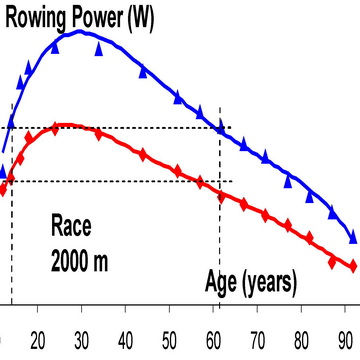
Did you that rowing power increases during youth, peaks around age 30, and then declines with age? Carlo Zezza, a rowing writer and an outstanding masters rower from Cambridge Boat Club, USA, at his 89th birthday, asked us a very interesting question: “I have thought for some time that my power losses between the ages of 83 and 88 mirror gains between the ages of 13 and 18, and that my fitness today is about the same as that of a fit 13-year-old. Do you have 2k erg figures for ages 12-13? … It would be interesting to compare…”
To answer this question, I analyzed world records on the Concept2 rowing machine across all 18 age categories from <12 to 100+ year-old, for both males and females, covering race distances from 100m to 42,195m (n=762).
The effects of age and both rowing speed and power in the standard 2000m race were approximated with fourth-order polynomial trends (R2>0.98). A direct answer to Carlo’s question does not confirm his hypothesis: Rowing power increases during youth, peaks around age 30, and then declines with age. However, these trends are not truly “mirrored.” Between the ages of 13 and 18, power gains are significantly steeper (+39 W/year in males and +20 W/year in females) compared to power losses between ages 83 and 89 (-9 W/year in males and -7 W/year in females). Additionally, even 12-year-olds demonstrate higher power output (above 300W in males and 250W in females) than 80+ year-old rowers (below 250W and 160W, respectively). The rowing power in the 13-14 age categories is similar to that of 60-64 year-old males (405-420W) and 55-59 year-old females (280-290W).
How these trends vary across different race distances? Similar age-related dependencies in rowing power for race distances ranging from 100m to 21,097m (half-marathon) were analysed. Across all race distances, power increases steeply during youth, peaks around age 30, and then gradually declines in older ages.
To better compare trends across distances, relative rowing power was calculated as the ratio of power in each age category to the absolute peak power for that distance (usually found in the elite 19-29 or 30-39 age groups). The overall trends are similar across all distances, but a few key differences emerge: Among teenagers, rowing power is significantly lower in long-distance races (21km), likely due to: 1) Lower endurance in young rowers compared to adults, 2) Lower participation and competition levels in longer events.
In the shortest race 100m, peak performance is typically achieved later (32+ years old) than in other distances, and relative power remains high in the middle age groups (40-60 years old).
Additionally, power output in the 500m race declines more sharply for rowers aged 60+, which may be attributed to reduced anaerobic training and lower lactate tolerance.
To analyse the relationship between rowing power P and race duration t for various age categories, it was approximated with the power equation P = a tb. Trends of absolute power were similar in the following age groups: 15-18 ≈ 40-59 years, and U14 ≈ 60-75 years.
Relative power was derived using the previously described method (RBN 2025/02) as a ratio to the power in the standard 2000m race. The power curves are generally consistent across all distances. The curves are slightly steeper for very young (U14) and older (40+) rowers, indicating that these groups tend to perform relatively better in shorter races and slower in longer distances.
The identified trends may have direct practical implications:
BioRow gold targets for elite rowers can be extended to additional age categories, enhancing the usefulness and precision of our analysis and feedback.
This is a short version of the Newsletter. To access the full text, please subscribe to BioRow membership.
©2025 Dr. Valery Kleshnev